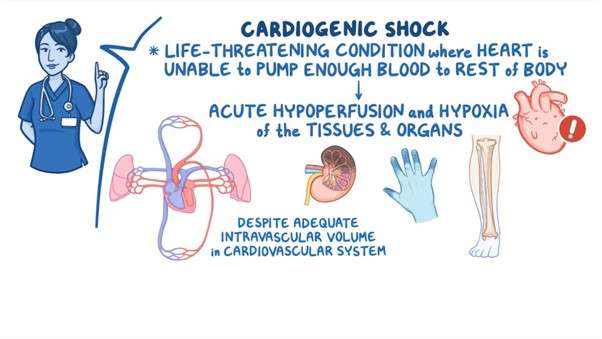The cardiac ICU nurse is assessing a patient who is in cardiogenic shock. Which hemodynamic manifestations and/or signs and symptoms do the nurse expect? Select all that apply.
Narrowed pulse pressure.
Tachycardia.
Elevated SBP.
Pulmonary congestion.
Pulmonary artery wedge pressure
Correct Answer : A,B,D,E
A. Narrowed pulse pressure: In cardiogenic shock, the cardiac output is compromised, resulting in reduced stroke volume and subsequent narrowed pulse pressure. The pulse pressure is the difference between systolic and diastolic blood pressure.
B. Tachycardia: Tachycardia is a compensatory response in cardiogenic shock, as the body attempts to increase cardiac output to maintain tissue perfusion despite decreased stroke volume. Increased heart rate is a common finding in this condition.
D. Pulmonary congestion: Cardiogenic shock is often associated with impaired left ventricular function, leading to an inadequate pump mechanism. This can result in fluid accumulation and congestion in the pulmonary circulation, leading to pulmonary edema and congestion. Patients may experience symptoms such as dyspnea, crackles on lung auscultation, and increased work of breathing.
E. Elevated pulmonary artery wedge pressure (PAWP): PAWP is a measurement obtained during invasive hemodynamic monitoring. In cardiogenic shock, the impaired left ventricular function leads to increased left atrial pressure, which is reflected by an elevated PAWP. Elevated PAWP indicates increased fluid volume and congestion in the left side of the heart.
C. Elevated SBP in (option C) is incorrect because Elevated systolic blood pressure (SBP) is not a typical finding in cardiogenic shock. Instead, hypotension or decreased blood pressure is commonly observed due to reduced cardiac output.

Nursing Test Bank
Naxlex Comprehensive Predictor Exams
Related Questions
Correct Answer is A
Explanation
Tachypnoea, which refers to an increased respiratory rate, is an early symptom of hypovolemic shock. It is the body's compensatory response to inadequate tissue perfusion and decreased oxygen delivery. The increased respiratory rate is an attempt to improve oxygenation and maintain vital organ function.
B. Heart blocks in (option B) are incorrect because Heart blocks refer to disruptions in the electrical conduction system of the heart and are not specific to hypovolemic shock.
C. Vomiting in (option C) is incorrect because: Vomiting may occur in various conditions, including shock, but it is not exclusive to hypovolemic shock and can be present in other forms of shock or illnesses.
D. Bradycardia in (option D) is incorrect because Bradycardia, or a slow heart rate, is not typically an early symptom of hypovolemic shock. Instead, tachycardia (rapid heart rate) is more commonly observed as a compensatory response to maintain cardiac output.
E. Hypotension in (option E) is incorrect because Hypotension, or low blood pressure, can occur in hypovolemic shock but is generally considered a later-stage symptom. In the early stages, compensatory mechanisms may help maintain blood pressure, so hypotension may not be present initially.
F. Bradypnea in (option F) is incorrect because: Bradypnea refers to a slow respiratory rate, which is not typically an early symptom of hypovolemic shock. Tachypnoea, as mentioned earlier, is the more common early respiratory symptom.
Correct Answer is D
Explanation
Norepinephrine is a potent vasoconstrictor and inotropic agent commonly used to increase blood pressure in cases of hypotension or shock. However, if the infusion rate is too high, it can lead to excessive vasoconstriction and potentially compromise organ perfusion.
A heart rate of 58 beats/min suggests bradycardia, which can be an indication of excessive vasoconstriction caused by a high dose or rate of norepinephrine infusion. Excessive vasoconstriction can reduce cardiac output and worsen tissue perfusion.
A. Mean arterial pressure is 55 mm Hg in (option A) is incorrect because A mean arterial pressure of 55 mm Hg may be within an acceptable range for a patient receiving norepinephrine infusion, depending on the patient's baseline blood pressure and clinical condition.
B. Systemic vascular resistance (SVR) is elevated in (option B) is incorrect because An elevated SVR indicates increased peripheral vascular resistance and can be a desired effect of norepinephrine infusion to improve blood pressure and perfusion.
C. Pulmonary artery wedge pressure (PAWP) is low in (option C) which is incorrect because A low PAWP may indicate decreased left ventricular preload, which can be a desired effect of norepinephrine infusion to reduce fluid overload in certain clinical conditions.
It is important for the nurse to carefully monitor the patient's hemodynamic parameters, including blood pressure, heart rate, and organ perfusion when titrating norepinephrine infusion to ensure optimal dosing and minimize potential adverse effects. If concerns arise regarding the infusion rate, the healthcare provider should be promptly notified for further evaluation and adjustment of the treatment plan.
Whether you are a student looking to ace your exams or a practicing nurse seeking to enhance your expertise , our nursing education contents will empower you with the confidence and competence to make a difference in the lives of patients and become a respected leader in the healthcare field.
Visit Naxlex, invest in your future and unlock endless possibilities with our unparalleled nursing education contents today
Report Wrong Answer on the Current Question
Do you disagree with the answer? If yes, what is your expected answer? Explain.
Kindly be descriptive with the issue you are facing.
